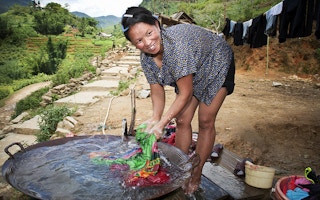To achieve gender equality and empower all women and girls – the fifth goal from the United Nation’s Sustainable Development Goals (SDGs) – programmes need to reframe the way society quantifies and values productivity.
To continue reading, subscribe to Eco‑Business.
There's something for everyone. We offer a range of subscription plans.
- Access our stories and receive our Insights Weekly newsletter with the free EB Member plan.
- Unlock unlimited access to our content and archive with EB Circle.
- Publish your content with EB Premium.
This means making women’s “unpaid work” in rural areas visible, such as their roles in caring for children and elders, collecting water and wood, cleaning and cooking, as well as farming and contributing to the preservation of natural resources.
These were the observations made by Maria Lee, a rural development specialist with WOCAN or Women Organising for Change in Agriculture & Natural Resource Management when she spoke at a panel discussion on gender equality at the Asia Europe Environment Forum Conference on SDGs last month.
WOCAN, a global women-led organisation, organises programmes around the world to advance women’s empowerment to tackle climate change, poverty and food insecurity.
The conference dubbed ‘Sustainable Development Goals for Asia and Europe: Delivery Options for Agenda 2030‘ was held in Stockholm, Sweden on 19-20 October and involved some 100 participants and speakers including government officials responsible for SDG implementation, civil society experts and academics.
It was organised by the Asia-Europe Environment Forum—an initiative which aims to deepen cooperation on sustainable development between the two regions—in partnership with the Asia-Europe Foundation (ASEF), Government of Sweden and Stockholm Environment Institute among others.
Closing the gap on gender inequality is the fifth goal in the UN’s SDGs, and many people see it as a pre-condition to achieving all the other 17 SDGs, which are a call to action to all countries to promote prosperity while protecting the planet.
Fellow panelist, Tasneem Kakal, a health advisor for Royal Tropical Institute (KIT), an Amsterdam-based knowledge institute, agreed that the goals were interlinked.
As an example, she explained the correlation between population dynamics and its impact on the environment, citing statistics that 40 per cent of pregnancies worldwide are unintended and 47 per cent of girls are married before the age of 18 in South Asia.
Kakal cited a UN SDG briefing source, that pointed out that achieving gender equality and with that, sexual and reproductive health and rights for women, would slow population growth, cutting 16-29 per cent of emissions by 2050.
For her part, Lee considered the economic impact of gender equality. She cited the 2015 Global Gender Gap Report from the World Economic Forum, which stated that Asia and the Pacific reportedly loses US$42 billion to US$47 billion annually as a region because of women’s limited access to employment opportunities.
She explained that society often categorises work and assigns a financial value to it, and typically accounts for revenue-generating or food-acquisition activities. Hence, women’s work is often invisible and their productivity is discounted.
As a result, programmes designed to increase productivity often fail to understand or identify how their investments benefit women, particularly in rural communities.
To address this issue, WOCAN has developed a results-based mechanism that quantifies, certifies and monetises benefits for women’s empowerment. Developed with rural women from Kenya and Nepal, the system measures the impact of projects on women’s empowerment in six domains: time, income/assets, health, leadership, education/knowledge and food security.
The measurement of progress results in women-benefit units (“W+” units) that buyers (individuals, companies, or other organisations) can purchase. The sale of units generates revenues that are shared with women beneficiaries and their groups.
In Nepal, the “W+” scheme has measured the time saved through the introduction of biogas and improved cooking stoves, amounting to an average of 2.2 hours a day per woman.
The women involved in the study were keen to use this newly freed up time for productive activities such as learning new farming techniques to grow new crops, to making home gardens, helping their children with school work and spending more time participating in community activities.
Eleven women’s groups in Nepal have received revenue from the sale of W+ units and have used it for buying goats, starting a savings and loan program and investing in a new water system.
Lee cited a UN Report, called “Progress of the world’s women 2015-2016” which stated that without any radical changes to the current pace of change, it will take 81 years to achieve gender parity in the workplace, more than 75 years to reach equal remuneration between men and women for work of equal value, and more than 30 years to reach gender balance in decision-making.
“With the right mix of economic and social policies, governments can generate decent jobs for women and ensure that the unpaid care work that goes into sustaining all economies is recognised and supported,” the UN Report said.










